This is a chronological list of items about Eric Arthur Wildman, London-based purveyor of canes, straps and birches, and campaigner for corporal punishment in the UK.
Click on each linked headline to go to the relevant item in The Archive.
 26 April 1947:
26 April 1947:
His business is simply whacking! (illustrated)
Eric Wildman (for it is he) gets a huge free plug in the then top-selling Daily Mirror tabloid. This is the earliest known picture of him, aged 26. It is also the only photo I have ever seen of him smiling. He already claims to be supplying canes to over 100 schools.
There is no news story or event to explain the sudden appearance of this item. It is just a picture of Wildman with his canes, apropos of nothing at all. Perhaps he had a chum on the Mirror staff.
4 July 1947:
Using his home address in Walthamstow, Wildman buys a small ad in the personal column on the front page of The Times:

29 August 1947:
Spanking story
Another fine piece of free publicity in the Daily Mirror. This time the "news peg" is that the government has supposedly stopped the import of canes (there was a desperate sterling crisis and only essential goods could be imported). Eric Wildman to the rescue! He allegedly has a thousand finished canes in stock.
Wildman is interviewed about his pro-caning campaign, the National Society for the Retention of Corporal Punishment in Schools. He maintains, a touch implausibly perhaps, that his "Corpun Educational Supply Company" is not supposed to be profit-making, and gives his usual spiel about how he sells canes to hundreds of schools all over the world. He even claims to be exporting them to Malaya, which, since that is one of the very places that rattan comes from in the first place, does not really seem terribly likely.
It is never explained what he might be living on, if not the proceeds of his trade. Nor does the Mirror hack ask how it comes about that a man of only 26 can present himself as the fount of all wisdom on the subject of corporal punishment, despite being neither a teacher (or, at least, clearly not a fulltime teacher in a school; he describes himself as a "tutor") nor, at that stage, a parent. The article gives Wildman's home address, which suggests that he has not yet established his offices in central London.
Also intriguing is the information that already in 1947 there was an organisation specifically campaigning to abolish CP in schools, with an office in Westminster. We are not told who was behind this precursor of the STOPP of three decades later; at all events, it seems to have made very little impact.
12 November 1947:
Eric Wildman is photographed in the streets of London:
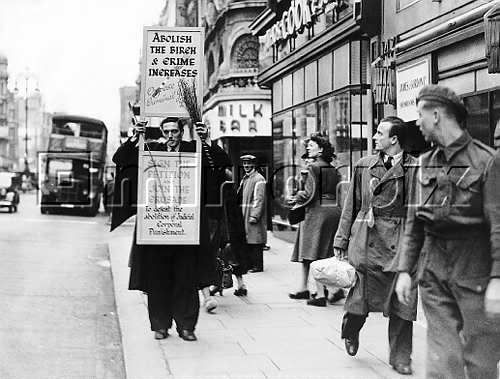
This is an agency file picture, captioned "Demonstration in 1947 showing Mr Eric Wildman in the streets of London with his propaganda boards petitioning against the abolition of corporal punishment". I cannot find that any newspaper actually used this photo.
Wildman poses with a sandwich board reading "Abolish the birch and crime increases. Sign the petition and join the crusade to defeat the abolition of Judicial Corporal Punishment". He is also holding a birch and a cane, and seems to be wearing a schoolmaster's gown. This was the week that Parliament was debating the Criminal Justice Bill, which was indeed to lead to the abolition of JCP the following year.
This looks like a staged publicity stunt -- I somehow doubt that he actually spent much time walking the streets -- but it is unusual for EAW in that it is about judicial, not school, CP, and appears on the face of it to be a purely political act, having only an indirect connection with his business.
9 July 1948:
The Times, in its list of that day's events, announces a public meeting at the Caxton Hall to launch the NSRCPS. Unfortunately I have not yet found any subsequent report of it:

1948:
The Corpun Educational Organisation, "in conjunction with the National Society for the Retention of Corporal Punishment in Schools", publishes a 9-page booklet, "Caning the schoolboy: whether at school or in the home".
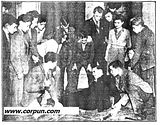 25 November 1948:
25 November 1948:
"Free Expression" School Scene (illustrated)
Pupils Cane Caner On Place He Recommended (illustrated)
Six strokes with a smoky Malacca: Schoolboy canes the cane seller (illustrated)
The unsuspecting Wildman, now sporting a moustache, is lured to a small (and, as it was to turn out, short-lived) boarding school in Staffordshire, Horsley Hall, to give his standard lecture, taking a supply of canes with him. Unbeknown to him, it is actually a "progressive", anti-CP school, and he is set upon by the students and whacked with one of his own canes. The press are there in force to record and photograph this embarrassing debacle in detail. Wildman makes himself look even more foolish by spluttering afterwards about the indignity of it all and threatening to take legal action, which of course never materialises.
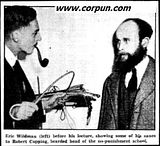 26 November 1948:
26 November 1948:
I had planned it all, says the head (illustrated)
The headmaster of Horsley Hall, here pictured with Wildman before the fateful lecture, confesses that the ambush of EAW by his students was all carefully planned. He seems to have conceived it as a political gesture against not just CP but "authoritarian" educational methods generally. Perhaps in reality he was just as much a publicity-seeker as Wildman; he certainly succeeded in getting his thitherto obscure little school into the headlines. What is remarkable with hindsight is how young he and Wildman were: both only in their 20s -- and both, some might feel, behaving rather immaturely.
 6 December 1948:
6 December 1948:
Six of the Best (illustrated)
The American magazine TIME catches up with the Horsley Hall story, giving us perhaps the best picture of the climactic moment.
19 February 1949:
Children of the World, Unite!
TIME magazine reports that the aforementioned progressive headmaster, Robert Copping of Horsley Hall, has held a public meeting in London to launch a new children's rights movement. Who should turn up but Eric Wildman, telling reporters that his cane business can only benefit from the chaos that such a development would bring.
18 April 1949:
How Progressive Can You Get? 
Wildman possibly experiences a touch of Schadenfreude at the news, reported here in TIME magazine, that Horsley Hall school is closed down by the authorities.
March 1950:
"This Boy Question", by Derek Belton: page 1 -- page 2 -- page 3 -- page 4 (images open in a new window)
Scans of four pages from "Corpun Educational Booklet 15A", a collection of duplicated sheets stapled together, "privately printed and published by Eric A. Wildman" at 335 City Road, EC1, price three shillings. The text seems innocuous, some of it arguably even quite sensible, and this surely cannot have been one of the publications later to be deemed "obscene".
This is the earliest mention I can find of EAW's central London offices.
August 1950:
"The Teenaged Girl, Part Two: Being a further collection of readers' letters, with Editorial comment", edited by Eric A. Wildman: page 1 -- page 2 -- page 3 -- page 4 -- page 5 -- page 6 (images open in a new window)
Scans of six pages from "Corpun International Educational Booklet No. 11", printed and published at 335 City Road, price five shillings. There were clearly reams more of this laughable stuff; I reproduce here only enough to convey the flavour. It may be that Wildman really did receive these "readers' letters", but he must have been extraordinarily naive if he could not see that they were plainly not true accounts, but fantasies concocted for purposes of titillation.
On the other hand, I think it is fair to say that, by today's standards, the idea that such feeble and silly material could possibly "deprave and corrupt" an adult reader (supposedly the legal test for obscenity at that time) seems completely absurd.
1950:
Wildman also publishes "Commonsense Punishment" and "The Young Parents' Guide". He also prepares "Modern Miss Delinquent" for publication and, a little later, "Punishment Posture for Girls", but according to p.61 of Ian Gibson's book, citing research by P. Fryer into banned material held under lock and key at the British Library, these last two were "withdrawn on legal advice before publication". However that may be, I believe there are people around who claim to possess a typescript of "Modern Miss Delinquent". I have not seen it myself.
1951:
Wildman publishes "Dress & discipline for the delinquent adolescent girl; being the first edition of readers' letters relative to the 'Grown-up school-girl' (Corpun educational booklets series)", and "Corporal Punishment in the Home".
1951:
The Corpun Educational Organisation publishes "The German Girl: Corporal Punishment in Germany and Austria" and "The Cleansing Cane", both by Eric A. Wildman.
September 1952:
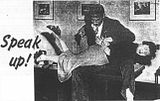 Speak up! (illustrated)
Speak up! (illustrated)
Wildman is photographed in an American magazine with a stenographer over his knee, pretending to cane her. This stunt takes place during a visit to New York "to display his birch rods and canes", to what purpose is not explained. Ordinary people could not afford to travel across the Atlantic in those days. Where did he get the money from? What was he hoping to achieve? It is all quite mysterious.
10 January 1953:
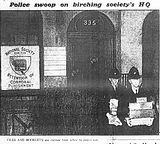 Police seize canes in swoop on offices
Police seize canes in swoop on offices
Booklets, straps and canes seized (illustrated)
Wildman's business appears to be thriving at its premises at City Road in central London, pictured. Unfortunately, however, some of his literature has attracted the attention of the authorities, who evidently thought it too salacious for those prim and repressive times. Wildman is pictured in a bowler hat. The Daily Mail has managed to get a photographer to the scene while the raid is still going on: either Wildman or the police have clearly tipped off the press.
13 February 1953:
Wildman's organisation, the National Society for the Retention of Corporal Punishment, gets mentioned in the House of Commons during a debate on a proposal for the reintroduction of JCP.
during a debate on a proposal for the reintroduction of JCP.
14 February 1953:
Charges under Obscene Publications Act
Wildman does not bother to attend his initial court hearing. He is charged with publishing "obscene" literature including "Girls' Specialist, supplement to the International Retentionist Gazette". The case is adjourned until April.
10 April 1953:
Raiders found 3,000 canes, court told
The "tall and well-dressed" Eric A. Wildman appears before the magistrate. Despite the headline, it is not the canes that are at issue, nor the "photographs dealing with whipping" also allegedly found on his premises, but "masses of obscene literature", which prosecuting counsel describes as "obviously pornographic and in no sense scientific works". The case is adjourned.
15 May 1953:
Wildman Guilty Of Obscene Libels
£500 fine for obscene libels
Wildman is fined £500. His own lawyer describes him as "A man with a kink". The judge starts off by intending to fine him £1,000, but is assured that EAW does not have that sort of money. If he cannot pay £500 he will go to prison for 12 months. Does he, in fact, come up with the cash? We are not told. One occasionally hears rumours that EAW actually did spend time in jail, but I have never found any documentary evidence for this.
It is true that £500 was quite a large sum in 1953, but the court gave him six months to pay. I should have thought that a man of Wildman's evident energy and resourcefulness would probably have been able to find a way of raising the money in that time, but I am only guessing.
It seems Wildman declined to give evidence, but his lawyer provides an account (in the Times version of the story) of how EAW got started in the CP trade. He claims that it began as a leather business making razor strops, but the leather was unsuitable, so he made it into punishment straps instead, and was astonished to be inundated with orders from schoolteachers, who also asked him for canes, whereupon he decided to market those as well.
27 October 1953:
Obscene books to be destroyed
Another court appearance, this time to show cause why all the documents seized by the police should not be destroyed. Wildman tells the court that he "would say they were obscene if it helped". The magistrate orders the destruction of "publications and papers, photographs, paintings and drawings, and a sound recording tape". There is nothing in this or any other report to suggest that EAW was currently, or had recently been, or was about to be, in prison.
11 July 1954:
'Flog them' man loses his canes
The police once more raid the premises of Eric Wildman, now aged 32 and still describing himself as President of the National Society for the Retention of Corporal Punishment. His stock-in-trade has all been confiscated, he says. The offices are to let. There seems to be no follow-up to this somewhat cryptic news item, and it remains unclear quite what was going on here.
17 November 1955:
The Australasian Post, a sensationalist magazine in Melbourne, bizarrely uses a picture of Wildman in his office (see top of this page) to illustrate a quite irrelevant article which, though headed "Corporal Punishment", is mainly about domestic violence. The caption alludes to the Horsley Hall affair, a story by this time seven years old, but makes no mention of Wildman's more recent difficulties. The photo, which itself is clearly some years out of date, shows EAW holding a birch and gazing pensively upon his stock of implements. On the wall hangs what seems to be a picture of himself in his Merchant Navy uniform.
1956:
Chastisement Across the Ages, Chapter VII
Gervas D'Olbert devotes several pages of his book to the saga of Eric Wildman. It is a witty account ("Wildman's publications reached no very high literary level ...") and a good read, which gives the impression -- unless he is just making it all up -- of being based on some personal experience of the man, and not on press cuttings merely; but unfortunately D'Olbert never cites specific sources for his assertions.
He is particularly interesting on Wildman's "grandiose scheme of publicity", involving, so he tells us, public meetings (at least one of which it rather looks as if D'Olbert must have attended), innumerable letters to the editors of local papers, and printed postcards on noticeboards all over London, inviting parents and teachers to contact him for advice on the upbringing of the young.
D'Olbert comes to the conclusion that Wildman was not only eccentric, lacking in common sense and "his own worst enemy", but actually somewhat deranged and a megalomaniac.
1966:
An Eric A. Wildman of London publishes "Empirically Yours", reproduced from typewriting, says the British Library catalogue.
August 1967:
The Court Lees Approved School Affair
From the Gibbens Report on allegations of excessive punishment at this boys' reformatory, it emerges that in October 1963, and again in July 1965, Court Lees staff ordered canes from "the Eric A. Wildman Tutelage Supply Company" of London E4 (Wildman having by this time moved the short distance from Walthamstow to Chingford). These canes were found to be half an inch in diameter -- somewhat heavier and thicker than the official canes approved by the Home Office.
As far as I can discover, EAW had done nothing newsworthy for some ten years and was never to do so again. It seems reasonable to conclude that the 1953 court case led him to cease his literary activities and his obsession with self-publicity, but that he went on quietly retailing canes by mail order from home throughout.
1971:
An Eric A. Wildman of London publishes "Understanding decimals and fractions, Tutor's notebook No. 2".
1974:
E.A. Wildman is still in the London phone book, offering "tutelage" from Chingford. There is some anecdotal evidence that in the 1960s and 1970s Wildman was making ends meet by giving private tuition in maths. Could it be that teaching maths was his main occupation all along and that, if you take a long view of his life, all that frenetic CP-related activity in the late 1940s and early 1950s was really a bit of a blip?
1977:
An Eric Arthur Wildman of South Woodford publishes "Understanding percentages, an Eric Wildman tutorial aid". Assuming this is he, our man is now at his third address in north-east London, all within a couple of miles of each other.
8 October 1977:
School canes sold through newsagent
A news item about where the Greater London Council gets its school canes from. The answer turns out to be a mysterious Canadian with an accommodation address at a faintly disreputable newsagent's shop in Leeds. A spokesman is quoted as saying that they were experiencing great difficulty in securing supplies. The story makes no mention of Eric Wildman, possibly suggesting that he had stopped trading by this time. Alternatively, I suppose it might just be that the GLC found his prices too high.
 21 April 1981:
21 April 1981:
Mr Whacko gets a caning
Those Erics in full:
The new kid on the cane-retailer's block is Eric Huntingdon of Bognor Regis, here pictured on the front page of The Sun.
Could they by any chance be related?
No. A glance at Huntingdon's photo confirms that this is certainly not Wildman in a new guise.
7 August 2008:
Whacks got a caning
A columnist on a local paper in East London reveals that he went to school with Eric Wildman in the 1930s. He describes Wildman as "a chump" and "an ass", and says he is now dead. (He would have been 87.)
2009:

Sixty years on, Horsley Hall in Staffordshire has been turned into luxury flats, one of which was recently on sale for £250,000.
2009:
335 City Road, London EC1, still stands:

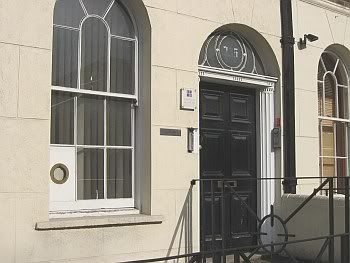
Doorway, windows and railings remain unchanged from 1953. The former cane emporium is currently home to graphic designers and accountants. They ought to put up a blue plaque!



![]() Country files: Corporal punishment in Britain
Country files: Corporal punishment in Britain